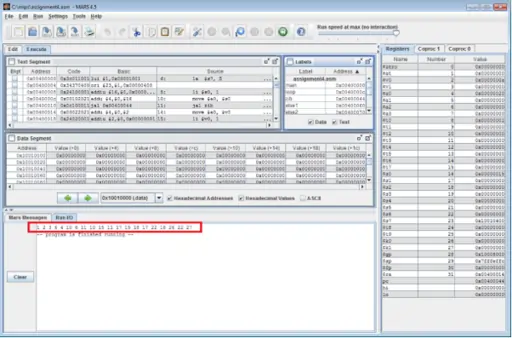Instructions
Objective
Write an assembly language assignment program to implement recursion in a program.
Requirements and Specifications
Below is a variation of a Fibonacci sequence, not an original. Many such variations exist.
Implement the below function using the MARS Mips assembler. Call the function repeatedly to produce the output as shown below. For your convenience you are given the function in symbolic and C code.
ZIBO NACCI
This is a weird rendition of Fibonacci which tends to calculate results which appear to zig and zag.
- zib(0) = 1
- zib(1) = 1
- zib(2) = 2
- zib(2n+1) = zib(n) + zib(n-1) + 1, if n>0 (odd values 3 and higher)
- zib(2n) = zib(n) + zib(n+1) + 1, if n>1 (even values 4 and higher)
The C program to calculate this looks like:
Part B
Written portion: Using your student number which will appear in the following format, abcDEFG. This will produce the two base 10 numbers, D.E x 102, and F.G x 103. Take your student number and substitute in the digits as shown above. Using the FPS website (see course home page) convert each over to a normalized binary form. Each should look something like 1.xxxxxxxx * 2y. Depending on your student number, the number of significant digits will vary.
For those students who have DE and/or FG equal to zero, i.e. 0.0x102, then substitute 34 for any occurrence of 00 to ensure a non-zero term.
Using the FPS multiplication shown in class, multiply the above numbers together, producing a FPS result. Show all work, that is where the marks are. You can verify your work by doing a base 10 multiplication and using the FPS website to verify the binary result.
Screenshots of output

Source Code
.data
RECORDS: .space 1024
S:
.text
main:
la $s7, S # load address of end of records in s7
li $s0, 1 # first number to calculate
loop:
move $a0, $s0 # pass number to subroutine
jal zib # zib(i)
# print number
move $a0, $v0 # move return value to a0 to print it
li $v0, 1 # syscall number to print integer
syscall
# print space
li $a0, 32 # load ascii space value
li $v0, 11 # syscall number to print character
syscall
addi $s0, $s0, 1 # increment number to calculate
ble $s0, 20, loop # repeat while number is below or equal to 20
# exit program
li $v0,10 # syscall number to exit program
syscall
#-------------------------------------------------------------------------------
# zib recursive subroutine, requires the number in a0, returns the result in v0
#-------------------------------------------------------------------------------
zib: # create new record in s7
addi $s7, $s7, -12 # allocate space to save 3 registers
sw $ra, 0($s7) # save ra in record
sw $s0, 4($s7) # save s0 in record
sw $s1, 8($s7) # save s1 in record
bne $a0, $zero, else1 # if (n == 0)
li $v0, 1 # return 1;
j return
else1:
bne $a0, 1, else2 # else if (n == 1)
li $v0, 1 # return 1;
j return
else2:
bne $a0, 2, else3 # else if (n == 2)
li $v0, 2 # return 2;
j return
else3:
andi $t0, $a0, 1 # else if (n%2 == 1 && n >= 3) // odd
beq $t0, $zero, else4
# return zib((n-1)/2) + zib((n-1)/2-1) + 1;
addi $a0, $a0, -1 # n-1
srl $a0, $a0, 1 # (n-1)/2
move $s0, $a0
jal zib # zib((n-1)/2)
move $s1, $v0 # save result in s1
addi $a0, $s0, -1 # (n-1)/2 -1
jal zib # zib((n-1)/2-1)
add $v0, $v0, $s1 # zib((n-1)/2) + zib((n-1)/2-1)
addi $v0, $v0, 1 # zib((n-1)/2) + zib((n-1)/2-1) + 1
j return
else4: # else if (n%2 == 0 && n >= 4) // even
# return zib(n/2) + zib(n/2+1) + 1;
srl $a0, $a0, 1 # n/2
move $s0, $a0
jal zib # zib(n/2)
move $s1, $v0 # save result in s1
addi $a0, $s0, 1 # n/2 +1
jal zib # zib(n/2+1)
add $v0, $v0, $s1 # zib(n/2) + zib(n/2+1)
addi $v0, $v0, 1 # zib(n/2) + zib(n/2+1) + 1
return:
# load old values from record and remove it
lw $ra, 0($s7) # load ra from record
lw $s0, 4($s7) # load s0 from record
lw $s1, 8($s7) # load s1 from record
addi $s7, $s7, 12 # remove space allocated for the record
jr $ra # return to caller
Related Samples
Explore our collection of free assembly language assignment samples designed to enhance your understanding and mastery of low-level programming concepts. Access these resources to deepen your knowledge and excel in your studies.
Assembly Language
Assembly Language
Assembly Language
Assembly Language
Assembly Language
Assembly Language
Assembly Language
Assembly Language
Assembly Language
Assembly Language
Assembly Language
Assembly Language
Assembly Language
Assembly Language
Assembly Language
Assembly Language
Assembly Language
Assembly Language
Assembly Language
Assembly Language
